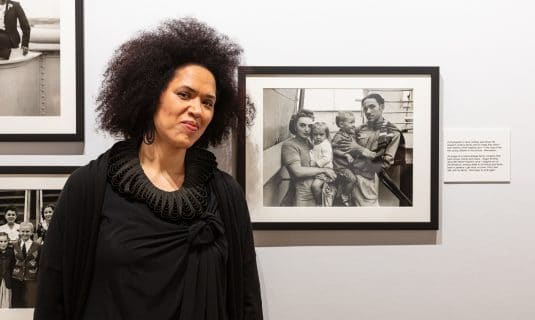Changing the Story Exhibition
On Wednesday 19th January, pupils were invited to attend a Private View of The North Wall’s important exhibition, Changing the Story: Photographs of British Life in Black and White (1917-1962) featuring a series of images from an overlooked part of British history, selected and interpreted by award-winning poet, playwright, theatre-maker, performer, librettist and academic, Dr Rommi Smith.
Sixth Former Patrick Maxwell reviews the exhibition below.
The phrase ‘making history’ is often used to describe our memorable actions in the present, but it provides a perfect description of Dr Rommi Smith’s work on a previously neglected past. Dr Smith’s new exhibition has set out not only to shift and reform traditional narrative of British history and identity, but to change the very way we think about constructing those narratives, about the processes by which we define a ‘national’ history. That means challenging the orthodox ways we present that history – in schools, universities, historical literature, cultural representation – with a rebuke of the traditional notions which have been unassumingly passed down through generations. As Chimdi Okonkwo, one of the Teddies Upper Sixth at the private view last week said: ‘The exhibit was a sign that there isn’t necessarily white history and black history. We just have history.’

Dr Rommi Smith (photograph by Iona Nicoll)
That aim has this as a central conviction: that British history was in no way the monocultural, monoracial blur of the textbooks. By taking a small number of pictures from the TopFoto archive, Dr Smith has, in her own words, curated a ‘stunning rebuke’ to the way that these images have been ‘airbrushed out of the British national photobook’. Her exhibition succeeds most in making them centre stage and bringing these stories, of immigrant families torn between aspirations for a British future and the harsh reality of a racially divided society, into a startling new light. Sixth Former Adriane Yeung said: ‘I found the exhibition incredibly moving. The celebration of Black History is so powerful and stunning, especially taking into consideration how rarely it is depicted as such, especially in education and the media. I really enjoyed the viewing, and I hope that the School continues to invite more POC artists and speakers to celebrate their histories and cultures.’
But it is not only the pictures of young people stepping off the HMS Windrush or even standing in naval uniforms during the First World War which are most powerful about this exhibition. More moving still is the depiction of everyday life, love, joy, hope; the pictures of multi-racial couples dancing in the Soho Clubs of the 1950s, or of the scenes of children playing on the Portobello Road. The crowds and couples are carefree, sharing a cigarette, dancing away the images of race riots, social discrimination and violence which have for too long been the only stories of Britain’s non-white heritage.
In those moments, Dr Smith has truly changed the story on our perceptions of a collective history. This is a history of ordinary people, the tales of communities transformed, disrupted, expanded through decades of life in a country which has always looked different to the picture we too often paint. This is what Chimdi saw as the ‘joy’ of black history, cutting through the usual narrative which seems ‘all about sadness’. This exhibition instead presents a history of ambition and oppression – of a nation which is still to this day coming to terms with itself. As Dr Smith said as she launched the exhibition on Wednesday night, we should be part of ‘changing that story’, making sure that it is these images of distinct humanity which are what make up a true ‘story of Britishness’ in which we can all share.